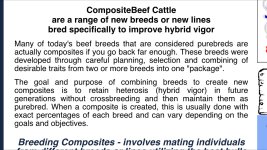We see things from both sides of the equation (dairy and beef) with our registries. Crossbreeding has been done in the beef industry for decades but not in the dairy industry so much, which is rapidly changing.
The Milking Fleckvieh was introduced to North America about 15 years ago. Montbeliarde, Swedish Red, Norwegian Red, Red Dane, Finnish Ayrshire. The Normande was first brought in in the latter 70's primarily for beef, but we were dairying at the time so I crossed some of our Holsteins with Normande bulls that seemed to offer more in the way of production. I liked the crosses.
The dairy industry seems to have a lot of naysayers when it comes to crossbreeding, but yet there is plenty of proof that crosses with Fleckvieh and Montbeliarde on Holstein the resulting offspring are milking right with or outproducing their Holstein herdmates.
Their is a study that is taking place in Minnesota on the ProCross animals. The ProCross is a 3-breed continual rotational breeding system, consisting of Holstein, Montbeliarde and the Viking Red. There have been other studies that have been done, but this is the most comprehensive study. The ProCross has continually shown their ability not only out produce the Holstein but have better reproductive traits, better health, last in the herd longer, and have better components.
The Viking Red can be fullblood Swedish Red and White, Finnish Ayrshire or Red Dane. The Red Dane themselves many times are a composite of Red Dane, Holstein, Brown Swiss, Milking Shorthorn, Norwegian Red and Swedish Red. But the Viking Red can also include Composite bulls that the genetics of the animals of the all the breeds.
Sometimes we see bulls that are Composites with 4 - 8 breeds in varying breed percentages. It has taken us some time to sort thru some of the pedigrees, but also sometimes what has happened is that a bull from one country was used in another country but they didn't want to recognize the original breeding of the bull. So they would give the bull a different name along with his parentage and most of the time they would use his original registration number from the home country but call him a different breed. It can get confusing.
These "Composite" bulls have very good proofs and are working well thru-out the world. Here in the US, on the most recent April evaluations, their is an elite list of cows that is released. The animals sired by Swedish Red bulls has the 3rd larges number of animals on that list right behind the Holstein and Jersey. Swedish Red sired animals outnumber Brown Swiss, Milking Shorthorn, Guernsey and Ayrshire. Further breakdown the "non-traditional" breed that we represent: Fleckvieh, Montbeliarde, Swedish Red and White, Norwegian Red, Finnish Ayrshire and Red Dane, make up almost 70% of the animals (excluding Holstein and Jersey).
Some of these "non-traditional" breed are allowed to be used in the Ayrshire and Milking Shorthorn breeds. But some of the bulls they don't tell the truth about their breed makeup. They only want to show certain breeds in the pedigree. With these breeds using outside genetics, and again looking at the April Elite list we see that the Ayrshire has 61% crosses and the Milking Shorthorn has 87% crosses of these breeds that made the list.
What is ironic the that beef producers like crossbred cows but are of the opinion that a purebred bull needs to be used, if a "Composite bull is used he is a mongrel). Dairy producers are taking the Holstein cow and when breeding to a "Red" breed bull are using a "Composite" bull that many times is a composite of 3 - 8 breeds.
It doesn't seem to make any difference on the opinion to beef producers on using "Composite" bulls even when their has been plenty of research done at MARC, Colleges and Universities and even at research centers in other countries.
Look at the Club Calf industry. Aren't most of those bulls "Composites". But how many of their REAL pedigrees are known. How many times do you see that a Club Calf bull is sired by a certain bull, but out of a Donor female that is listed maybe as "Smiths Donor 815B" (or whatever they want to call her). What breeds are in their makeup? or Maybe how many breeds? What genetic defect are lurking?

